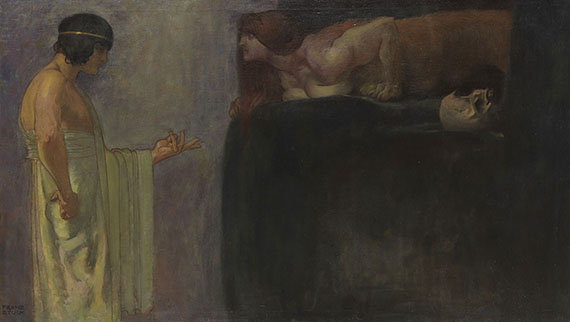Dictionary


Russian Symbolism
Russia proved to be quite susceptible to Symbolism. Its mysticism offered an opportunity to depict spiritual contents in art, which was on a par with Russia's deeply religious spirit. The center of the Russian symbolist movement was a group of artists that left the St. Petersburg academy in 1899, together they founded the magazine "Mir Iskusstva" (English: The Art World). It was their aim to spread international art from centers such as Munich, Berlin, Vienna and Paris, at the same time they intended to promote a new esthetic in painting. Thus Russian Symbolism combined spiritual contents with stylistic features of the European avant-garde. The movement had already exhausted most of its possibilities by 1908, and most artists began looking for new fields of activity.
The different symbolist artists shared the common opinion of art as a means of communicating hidden spiritual contents, they also had a deep interest in literary topics as well as in fantastic depictions that were coined by dreams and myths. Enigmatic, sometimes seductive women as well as exotic and primitive elements contributed to a characteristically mysterious atmosphere. However, the works show different stylistic features. The works of the most important Russian symbolist painter, Mikhail A. Vrubel, are characterized by his studies of medieval mosaics and Cubist and Futurist elements, whereas Viktor Borisov-Musatov's works were rather geared at the French avant-garde. The artistic origin of the Russian artists of Classic Modernism - such as Wassily Kandinsky or Kazimir Malevich - can be found in Symbolism.
Other important representatives of Russian Symbolism are Viktor Samirailo, Léon Bakst and Constantin Somov.
Russia proved to be quite susceptible to Symbolism. Its mysticism offered an opportunity to depict spiritual contents in art, which was on a par with Russia's deeply religious spirit. The center of the Russian symbolist movement was a group of artists that left the St. Petersburg academy in 1899, together they founded the magazine "Mir Iskusstva" (English: The Art World). It was their aim to spread international art from centers such as Munich, Berlin, Vienna and Paris, at the same time they intended to promote a new esthetic in painting. Thus Russian Symbolism combined spiritual contents with stylistic features of the European avant-garde. The movement had already exhausted most of its possibilities by 1908, and most artists began looking for new fields of activity.
The different symbolist artists shared the common opinion of art as a means of communicating hidden spiritual contents, they also had a deep interest in literary topics as well as in fantastic depictions that were coined by dreams and myths. Enigmatic, sometimes seductive women as well as exotic and primitive elements contributed to a characteristically mysterious atmosphere. However, the works show different stylistic features. The works of the most important Russian symbolist painter, Mikhail A. Vrubel, are characterized by his studies of medieval mosaics and Cubist and Futurist elements, whereas Viktor Borisov-Musatov's works were rather geared at the French avant-garde. The artistic origin of the Russian artists of Classic Modernism - such as Wassily Kandinsky or Kazimir Malevich - can be found in Symbolism.
Other important representatives of Russian Symbolism are Viktor Samirailo, Léon Bakst and Constantin Somov.
Offers
Headquarters
Joseph-Wild-Str. 18
81829 Munich
Phone: +49 89 55 244-0
Fax: +49 89 55 244-177
info@kettererkunst.de
Louisa von Saucken / Undine Schleifer
Holstenwall 5
20355 Hamburg
Phone: +49 40 37 49 61-0
Fax: +49 40 37 49 61-66
infohamburg@kettererkunst.de
Dr. Simone Wiechers / Nane Schlage
Fasanenstr. 70
10719 Berlin
Phone: +49 30 88 67 53-63
Fax: +49 30 88 67 56-43
infoberlin@kettererkunst.de
Cordula Lichtenberg
Gertrudenstraße 24-28
50667 Cologne
Phone: +49 221 510 908-15
infokoeln@kettererkunst.de
Hessen
Rhineland-Palatinate
Miriam Heß
Phone: +49 62 21 58 80-038
Fax: +49 62 21 58 80-595
infoheidelberg@kettererkunst.de
We will inform you in time.




